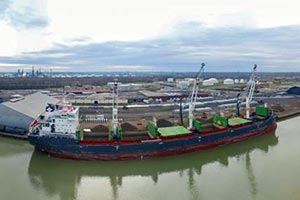Port of Toledo Tonnage Falls 30% in 2015 as Commodities Slump

A slumping steel industry led to declines in several key commodities across the Port of Toledo’s docks last year that accounted for most of a nearly 30% plunge in cargo tonnage.
Iron ore and coal, the port’s two biggest commodities by weight, both fell by more than 43%, with the former entirely reflecting steel’s woes and the latter hit both by that and declining coal consumption by electric utilities in both the United States and Canada.
Port officials acknowledged those declines Jan. 14 but also highlighted some bright spots in the numbers.
Joe Cappel, vice president of business development for the Toledo-Lucas County Port Authority, said a rebound could be coming in 2016 in the critical general-cargo sector, which includes high-value shipments such as aluminum, machinery and industrial equipment.
Reinstatement of federal tax incentives for wind-power development projects should bring back shipments of wind-turbine components in 2016 that came through the Toledo port earlier this decade, Cappel said.
“Coal and ore may continue to be a bit of a challenge,” but efforts to diversify Toledo’s cargoes will continue, and leads on wind-related traffic and machinery imports for local refineries are both promising, he said.
Betty Sutton, administrator of the federal Saint Lawrence Seaway Development Commission, said declining coal and ore volumes were hardly unique to Toledo, while the local port’s grain performance, lower than in 2014, was better than many others’.
“In 2014, we had a great fall harvest, plus a large carryover from the previous year, which we didn’t have in 2015,” Sutton said.
Also affecting grain in 2015, she said, was a bumper wheat crop in Russia that depressed world prices, causing American exports to drop.
Toledo’s aluminum traffic, Sutton said, supports jobs not only at the port but in the auto industry, and machinery and equipment are also important growth areas.
Those cargoes are not well represented in traffic numbers based on weight, she and Cappel said, but so far officials have yet to devise a better yardstick for measuring their port impacts.
Dry-bulk traffic, some of it at the port’s growing Ironville Terminal, was the one commodity sector that increased.
Much of Ironville’s 344,000 tons of maritime traffic was railroad ballast stone, Cappel said, but “they’re starting to expand into other bulk materials,” including non-railroad stone and mill scale.
Like the much older Toledo World Industries dock, Ironville is operated on the port authority’s behalf by Midwest Terminals of Toledo International, a stevedore company.
The 3,371,810-ton combined decline of coal and iron ore in 2015 accounted for an overwhelming majority of the Toledo port’s 3,411,347-ton drop in total cargo tonnage, which is a 29.27% decline.
Coal, historically Toledo’s heaviest-volume cargo but second to iron ore in recent years, fell below 2 million tons for the first time since local record-keeping began in 1947.
The 1,920,339 tons of coal through the Presque Isle Dock, which CSX Transportation operates under a lease from the port authority, marked a 45% decline from 2014’s traffic there. The previous record low had been set in 2012.
Cappel said he did not immediately know how coal’s decline broke between utility users, which have been reducing coal-burning capacity in response to both stricter pollution-control regulations and abundant natural-gas supply from fracking, and steelmakers, which suffered from a worldwide glut in 2015.
But steel’s struggles were further demonstrated in the 1.8-million-ton decline at Toledo’s iron-ore dock, also operated by CSX. All of the ore trans-shipped in Toledo goes to AK Steel mills in Ashland, Kentucky, and Middletown, Ohio, and Cappel noted that AK shut down its Ashland furnaces during 2015 and cut production in Middletown.
United States steelmakers have sought federal intervention recently against Chinese steel producers, which they accuse of glutting the world market with subsidized steel following the collapse of a construction boom in their home country.
Declining steel imports from other foreign countries, Cappel said, also contributed to a 35% drop in general and miscellaneous cargo at Toledo’s port last year, but that number would have been even deeper if not for the robust aluminum traffic.
Toledo’s coal business, meanwhile, could get some help in 2016 from railroad facility consolidation.
Norfolk Southern announced late last year that it is closing a coal dock in Ashtabula, Ohio, that it shared with CSX Transportation. Norfolk Southern will shift coal previously unloaded in Ashtabula to a dock in Sandusky, while CSX’s only other Great Lakes coal dock is the Toledo facility.

